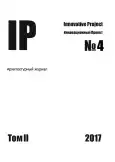Том 2, № 4 (2017)
ИСТОРИИ ГОРОДА
ЖИВАЯ ИСТОРИЯ ЛИНЕЙНОГО ГОРОДА
Аннотация
Рассматривается история градостроительного проекта «Линейный город», оказавшего впоследствии серьёзное влияние на теорию градостроительства во всём мире. Проанализированы причины его возникновения и основные идеи, которые его автор, испанский инженер и предприниматель Артуро Сориа, попытался своим проектом реализовать. Изложена подробная хронология возникновения проекта, первоначальных успехов в его реализации, возникших трудностей, с анализом их возможных причин, которые привели в дальнейшем к искажению исходных принципов проекта, полной остановке его развития, последующей деградации и окончательному краху. На том месте, где когда-то располагался мадридский Линейный город, сегодня о нём напоминает лишь станция метро с таким названием и главная улица, носящая имя его автора. Большинство материалов исследования впервые представлены на русском языке, а часть материалов впервые публикуются в научной литературе.
Innovative Project. 2017;2(4):6-34
 6-34
6-34


ПРОСТРАНСТВО ГОРОДА
ДОМ, ГОРОД, БАЗИЛИКА: МЕТАМОРФОЗЫ ИНВАРИАНТНОГО КОДА В СТРУКТУРЕ АРХИТЕКТУРНОГО ПЛАНА
Аннотация
В статье анализируется структура архитектурного плана с позиции влияния на него инвариантных кодов, присущих одновременно таким типам объектов - как дом, город и базилика. Наличие инвариантного кода гарантирует своего рода топологическую устойчивость структуры, невзирая на эксперименты с формой объекта. Представление о топологическом построении складывается на основе аналитических диаграмм, совмещаемых с изображениями планов. Разрушение или девиации кода вызывают вопросы по поводу возможности эффективного функционирования во всех подсистемах объекта. С другой стороны, именно намеренные эксперименты с планом, открывают нам путь к преодолению нормативного сценария архофункции в интересах пространственного приключения и новых «архитектурных историй».
Innovative Project. 2017;2(4):36-48
 36-48
36-48


ЧЕЛОВЕК И ГОРОД
ЮЖНЫЙ ГОРОД. НАЧАЛО
Аннотация
Статья посвящена новому явлению в современном российском градостроительстве - комплексному жилому району, расположенному на свободном участке в непосредственной близости к крупнейшему городу. Статья носит информационный характер и рассказывает о истории проектирования одного из таких жилых районов, о структуре жилой группы, о целях и задачах, которые ставились в процессе проектирования. В статье раскрывается методика проектных работ в режиме девелоперского бизнес проекта. Эти сведения помогут лучше понять это новое градостроительное явление, значение которого пока трудно предсказать. Будет ли новый жилой район, по численности населения равный крупному городу, оттягивать ресурсы у метрополии или это проявление роста агломерации, связанное с дальнейшей модернизацией российского общества и ростом урбанизации?
Innovative Project. 2017;2(4):50-58
 50-58
50-58


ГОРОД В ДВИЖЕНИИ
ГОРОД И ДОРОГА. МЫСЛИ О ПРОСПЕКТЕ КАРЛА МАРКСА В САМАРЕ
Аннотация
Описана функция дорожной сети города как одного из условий его формирования и существования, а также особенности её строительства в Советском Союзе при движении к светлому будущему. Приведён пример проспекта Карла Маркса в Самаре, уже более 90 лет присутствующего в планах развития города, но, несмотря на выделение земель под строительство, до сих пор не построенного. Обсуждаются последствия незавершённого строительства для дорожного движения и для городской среды окружающих жилых районов, а также его состояние на сегодняшний день и возможные последствия его успешного завершения в будущем. Описана разница в приоритетах для дорожного и жилищного строительства в современных российских городах как причина хронического ухудшения транспортной ситуации, а также постоянного невыполнения планов по городскому дорожному строительству.
Innovative Project. 2017;2(4):60-69
 60-69
60-69


ГОРОД ВНЕ ГОРОДА
ОБЪЕКТИВНЫЕ ПРИЧИНЫ ОСВОЕНИЯ ЭКСТРЕМАЛЬНЫХ СРЕД
Аннотация
Эволюция проектной культуры, совпадает с исторически обусловленной моделью освоения большого количества новых территорий и является своеобразной моделью, которая иллюстрирует эволюцию видов в живой природе. Стремление осваивать новые территории является генетически обусловленной необходимостью. Естественно, что человек на протяжении всей истории стремился освоить неосвоенное и познать непознанное. В наши дни экстремальная среда - это самое многообещающее направление архитектурной науки. Мы можем видеть, что задача изучения космического пространства дополняется задачей использования изучаемой среды.
Innovative Project. 2017;2(4):72-76
 72-76
72-76


МАСТЕРСКАЯ
ФЕНОМЕНОЛОГИЧЕСКАЯ МОДЕЛЬ МИРА В СРЕДОВОМ ПРОЕКТИРОВАНИИ
Аннотация
В архитектурной теории и практике существует тенденция обращения к феноменологическим концепциям. Это связано с тем, что они способны реабилитировать значения архитектуры, репрессированные вследствие гуманистического кризиса, спроецированного на современный метод проектирования: тела, чувства, места, природы, памяти и т.п. В статье авторы на основе интерпретации идей М. Хайдеггера применительно к средовому проектированию предлагают концепцию феноменологической модели мира, описывающей взаимосвязь реальности и объекта проектирования. Выдвинута гипотеза, что данная модель может выступать в качестве методологической основы средового проектирования с применением феноменологического подхода. Авторы обосновывают вероятность гипотезы путём анализа творческих методов архитекторов феноменологической архитектуры С. Холла, П. Цумтора, школы МАРШ, мастерской С. Малахова и Е. Репиной на основе предлагаемой модели. Гипотеза подтверждается в курсовом проектировании с применением модели.
Innovative Project. 2017;2(4):78-94
 78-94
78-94


КОРОТКО
ТЕОРИЯ И МЕТОД
Аннотация
В статье рассматривается отличие разных подходов к архитектурной теории: рожденной из индивидуальной проектной практики, от основанной на построении принципиально новой картины проектной и архитектурной деятельности. Обсуждаются различия теорий, ориентированных на конечный результат, от теорий, предполагающих постоянную собственную перестройку.
Innovative Project. 2017;2(4):96-98
 96-98
96-98











